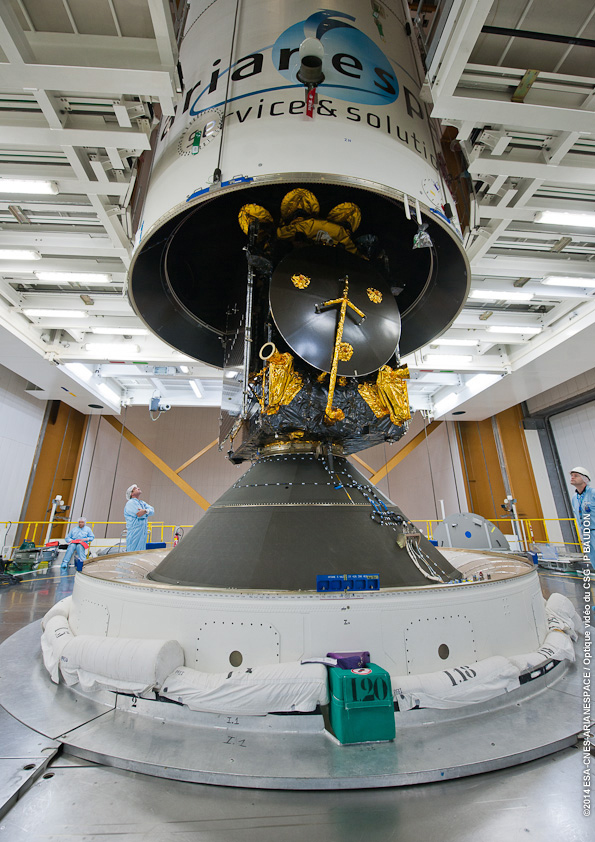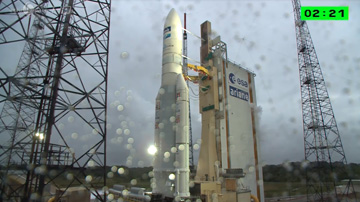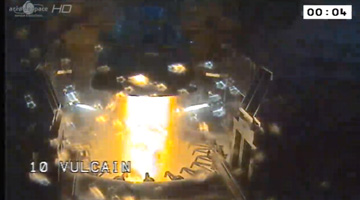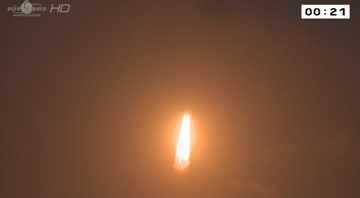
Arianespace, the Paris-headquartered launch services organization, which operates the small Vega, medium Soyuz and giant Ariane 5 boosters out of the Guiana Space Centre in Kourou, French Guiana, has triumphantly kicked off an impressive salvo of launches from the South American spaceport with its first mission of 2014. Liftoff of Mission VA-217—with an Ariane 5 carrying the joint French/Italian Athena-Fidus military communications satellite and the ABS-2 commercial communications satellite for Asia Broadcast Satellite into geostationary transfer orbit—occurred at 6:30 p.m. GFT (4:30 p.m. EST) Thursday, 6 February, following a 60-minute delay caused by heavy rain, ground winds and an elevated risk of lightning. Fortunately, today’s expansive, 125-minute “window” offered Arianespace the luxury of holding the countdown clock to wait for improvements.
Today’s mission is the first Ariane 5 launch since last August. It represents the 72nd flight by an Ariane 5, which undertook its maiden voyage in June 1996, and the 216th overall mission by Arianespace since the first launch of an Ariane 1 booster, way back in December 1979. Original plans called for Mission VA-216 to carry the Amazonas-4A communications satellite for Spain’s Hispasat company and the Astra-5B communications satellite for Luxembourg-based SES in mid-December 2013, but the launch order was switched. On 19 December, Arianespace announced that VA-217 would fly before VA-216. In making the announcement, chairman and CEO Stéphane Israël thanked the clients of both missions “for their trust” and praised the “excellent collaboration between our teams”, as well as highlighting Arianespace’s own “commitment and flexibility”.
Revised plans called for VA-217 to fly on 23 January, followed by VA-216 on 19 February. This schedule was also upset when the nozzle of the second stage cryogenic engine of the VA-217 vehicle suffered accidental damage and required replacement. The stack was transferred to the Final Assembly Building (BAF) for the replacement work and Arianespace announced early last month that the launch had slipped by two weeks until no earlier than 6 February. Assembly of the Ariane 5’s 100-foot-tall (30-meter) “cryotechnic main stage” got underway at the Guiana Space Centre last fall and by November it had been installed onto its operational launch table in the Launcher Integration Building (BIL). The next step was the attachment of its twin solid-fueled boosters, followed by the cryogenic second stage and Vehicle Equipment Bay (VEB), which contains the rocket’s computerized “brain”.In the meantime, processing of the Athena-Fidus and ABS-2 payloads was proceeding with exceptional smoothness. Both satellites arrived separately at Félix Éboué Airport, near French Guiana’s capital, Cayenne, in early December, aboard chartered An-124 transport aircraft. They were then transferred by truck to the Guiana Space Centre. Following unpacking and intial checks, they were transferred to the S5 payload preparation center and loaded with propellants and high-pressure gases. Last week, inside the BAF, they were lowered into their respective positions within the two-tiered SYLDA (Système de Lancement Double Ariane) satellite dispenser atop the Ariane 5. The ABS-2 satellite occupied the upper deck of the SYLDA, with Athena-Fidus located beneath it in the lower deck.

On Tuesday, a launch readiness review concluded with a unanimous “Go” to proceed with final launch preparations and yesterday the VA-217 stack was rolled out from the BAF to the ELA-3 (Ensemble de Lancement Ariane) launch zone. As noted by Mr. Israël in his opening address on Arianespace TV’s live feed, the mission supported a payload-lift performance of more than 22,500 pounds (10,200 kg), which includes a combined total of over 20,700 pounds (9,400 kg) for the two satellite cargoes, the SYLDA and their integration hardware. No sooner had Mr. Israël finished speaking, however, it became clear that weather conditions at the launch site would present an obstacle, with rain, ground winds and the risk of lightning leading to a temporary hold in the countdown as weather was classified as “Red” (“No Go”). All other vehicle systems and stations remained “Green” (“Go”). With the weather presenting the sole stumbling block, the countdown was halted at T-7 minutes, at 5:23 p.m. GFT (3:23 p.m. EST), and a 30-minute delay was called.
Today’s expansive launch window ran for 125 minutes, from 5:30 p.m. GFT (3:30 p.m. EST) until 7:35 p.m. GFT (5:35 p.m. EST), offering plenty of scope for the Arianespace launch team to monitor the weather and still be in a position to resume the countdown at a later stage. With the exception of the weather, all final preparations for the VA-217 launch had run smoothly. The loading of 260,000 pounds (118,000 kg) of liquid oxygen and 50,000 pounds (22,700 kg) of liquid hydrogen for the French-built Vulcain-2 engine on the rocket’s first stage got underway at T-4 hours and 50 minutes. Approximately 90 minutes later, the process of chilling down the Vulcain’s fuel lines began and at T-1 hour and 10 minutes connections between Ariane 5 and the telemetry, tracking and command systems were checked and verified. Under normal circumstances, at T-7 minutes the launch team would have been polled for their recommendation and would have issued an “All Systems Go” report, thereby kicking off the Synchronized Sequence of events which controlled the final minutes of the countdown. With the weather presenting the only bad card, the clock was halted at that point.
By 5:50 p.m. GFT (3:50 p.m. EST), conditions still looked gloomy and the launch commentator announced a new T-0 time of 6:30 p.m. GFT (4:30 p.m. EST), with a weather briefing about ten minutes before liftoff. Shortly afterwards, at 6:23 p.m. GFT (4:23 p.m. EST), the clock resumed counting down from T-7 minutes.

Ariane 5’s propellant tanks were pressurized for flight at T-4 minutes and the 171-foot-tall (52-meter) vehicle was transferred to internal power. In the final seconds, systems aboard the rocket assumed primary command of all critical functions and the guidance system was unlocked to Flight Mode. The Vulcain-2 engine roared to life at T-0, producing 300,000 pounds (136,000 kg) of thrust, although liftoff would not occur for another 7.5 seconds, as a series of computer-controlled health checks were conducted.
When all was verified to be well, the twin side-mounted solid-fueled boosters—each with a propulsive yield of 1.4 million pounds (635,000 kg) and together generating 92 percent of the total thrust to get the Ariane 5 off the pad—ignited and VA-217 was committed to flight.
The stack rose vertically for about five seconds, after which the two computers inside the VEB initiated a combined pitch and roll program maneuver, actively rotating the vehicle onto the correct flight azimuth to insert Athena-Fidus and ABS-2 into orbit. One minute into the ascent, the vehicle went supersonic and passed through “Max Q,” the period of maximum aerodynamic stress on the airframe. The twin solid-fueled boosters were exhausted and jettisoned at T+142 seconds, parachuting into the Atlantic Ocean about 300 miles (480 km) east of the launch site. Meanwhile, Ariane 5 had now reached a velocity of over 1,200 mph (1,900 km/h) and continued to climb under the impulse of the Vulcain-2 engine. Three and a half minutes into the flight, the bullet-like payload shroud was detached, exposing the twin satellite cargoes to the space environment for the first time.
Shutdown of the Vulcain-2 occurred at T+8 minutes and 53 seconds and the cryotechnic main stage descended to a splashdown off the coast of Africa, in the Gulf of Guinea, far to the south of Liberia and Côte d’Ivoire. Meanwhile, the second stage—powered by a restartable, 6,100-pound-thrust (2,770 kg) engine—ignited to pick up the baton for the final push into orbit. By now, the rocket was over 105 miles (170 km) high and traveling at more than 4,300 mph (6,900 km/h). Sixteen minutes later, having reached a velocity of 5,700 mph (9,170 km/h), Geostationary Transfer Orbit (GTO) was attained. The target orbit was 153 x 22,330 miles (246 x 35,937 km), inclined six degrees to the equator.

With ABS-2 sitting in the uppermost payload deck of the SYLDA, it was the first satellite to be deployed, at about 27 minutes and 19 seconds after liftoff. During a 15-year operational lifespan, it is expected that the 13,960-pound (6,330 kg) satellite will provide direct-to-home and cable television, data networks and telecommunications for 60 percent of the world’s population, covering Russia, North Africa, Asia and the Middle East. With a payload power output of more than 12 kW and up to 89 active C-band, Ku-band and Ka-band transponders across ten different beams, it is one of the most powerful commercial communications satellites ever positioned over the Eastern Hemisphere. ABS-2 was built by Space Systems/Loral (SS/L) and will be stationed at 75 degrees East longitude, the prime geostationary orbital location for Asia Broadcast Satellite.
Five minutes after the ABS-2 deployment, at T+32 minutes and 28 seconds, Athena-Fidus—the lower passenger in the SYLDA—was released, effectively completing the VA-217 mission. “Athena-Fidus” is an acronym for the “Access on THeatres for European Nations Allied Force-French/Italian Dual-Use Satellite” and has been built by Thales Alenia Space on behalf of France’s Centre National d’études Spatiales (CNES, the French National Centre for Space Studies), the Italian Space Agency (ASI) and the French and Italian defense ministries. The 6,600-pound (3,000 kg) satellite will utilize the latest telecommunications standards, DVB-RCS and DVB-S2, to ensure optimum transmission capacity and service availability. Equipped with Extremely High Frequency (EHF) and Ka-band transponders, it will support the defense requirements for France, Italy and Belgium, whilst also providing assistance in civil and national security, law enforcement and firefighting. Designed for an operational life span of 15 years, Athena-Fidus will be positioned at 25 degrees East longitude.
With Mission VA-217, Arianespace has thus marked the first launch of an Ariane 5 in 2014, with two more flights currently planned for the vehicle. Mission VA-216 on 7 March will deliver Amazonas-4A and Astra-5B into geostationary transfer orbit and the fifth and final Automated Transfer Vehicle (ATV-5), named in honor of the late Belgian astronomer Georges Lemaître, will be launched on behalf of the European Space Agency (ESA) on 17 June. This compares favorably with 2013’s completion of no fewer than four Ariane 5 missions. Last year, the booster delivered the Amazonas-3 and Azerspace-1/Africasat-1A satellites into orbit in February, followed by ATV-4 “Albert Einstein” to the International Space Station (ISS) in June, the Alphasat and Insat-3D satellites in July and the Eutelsat-25B/Es’hail-1 and GSAT-7 satellites in August.
Want to keep up-to-date with all things space? Be sure to “Like” AmericaSpace on Facebook and follow us on Twitter: @AmericaSpace
Missions » ABS-2 »


